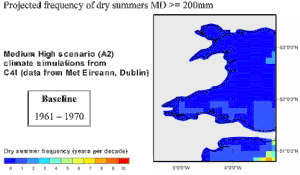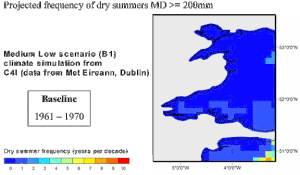Summary
All of the climate projections based on scenarios of future green-house gas emissions suggest that the climate will become warmer and more variable. In future decades it is likely that warmer and drier summers will become more frequent although punctuated with wet and cooler summers. Such changes in the variability of growing seasons poses problems for trees that are less able to tolerate extremes, such as droughty summers and fluctuating soil wetness. Sitka spruce, beech and ash are fairly drought sensitive and are likely to be affected by dry summers.
The animation (below) provides a glimpse of the projected change in frequency of dry summers, defined as the number of years per decade the moisture deficit is equal to, or exceeds, 200 mm. The animation starts with the 3 decades of the climate baseline period 1961-1990, followed by 1991 -2000, and then jumps to simulations for future decades:
- 4 decades covering the period 2021-2060 for the B1 (Medium-Low emissions scenario)
- 8 decades covering the period 2021-2100 for the A2 (Medium-High emissions scenario).
These maps were calculated from data provided by C4i (Community Climate Change Consortium for Ireland) based on projections from a regional climate model for the Medium-Low (B1) and Medium-High (A2) emissions scenarios. The regional climate model climate change simulations for Ireland cover an area which includes the whole of Wales.
Medium High scenario (A2) climate simulation:

Medium Low scenario (B1) climate simulation:

